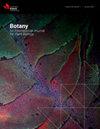Effects of large-scale restoration on understory plant communities in an industrial landscape
IF 1.3
4区 生物学
Q3 PLANT SCIENCES
引用次数: 0
Abstract
Botany, Ahead of Print.Starting in the mid 1970’s, researchers, industry leaders, and residents collaborated on one of the world’s largest regreening programs in the industrial region of Sudbury, Canada. The Sudbury Regreening Recipe included the application of crushed dolomitic limestone, nitrogen–phosphorus–potassium fertilizers, grass–legume seed mixtures across 8200 ha, and subsequent tree planting across 25 000 ha of acidic metal-contaminated land. The current study evaluated shifts in understory vegetation diversity and soil geochemistry on a chronosequence of sites treated the same way between 1982 and 2012. Fifty-six plant species were identified across the 24 sites, only four of which were planted in the initial remediation effort. Key factors influencing plant community composition and diversity were related to shifts in soil properties over time: bulk density, LFH layer depth, and mineral soil horizon pH. Plant communities differed with stand age and rocky sites had significantly different plant communities and lower canopy cover than less rocky sites. Mineral soil horizon pH increased with age, reflecting the movement of applied dolomite in soil. Despite high concentrations of total copper and nickel in soil, plant succession patterns were generally similar to those in naturally recovering forests demonstrating the overall success of the restoration program.
大规模恢复对工业景观林下植物群落的影响
植物学,提前印刷。 从 20 世纪 70 年代中期开始,研究人员、行业领袖和居民在加拿大萨德伯里工业区合作开展了世界上最大的绿化计划之一。萨德伯里植树造林方案包括在 8200 公顷的酸性金属污染土地上施用碎白云石石灰石、氮磷钾肥料和草-豆种子混合物,随后在 25000 公顷的酸性金属污染土地上植树造林。目前的研究评估了 1982 年至 2012 年间在相同处理方式的地点上林下植被多样性和土壤地球化学的变化。在这 24 个地点发现了 56 种植物,其中只有 4 种是在最初的修复工作中种植的。影响植物群落组成和多样性的关键因素与土壤性质随时间的变化有关:容重、LFH 层深度和矿质土壤层 pH 值。植物群落随林地年龄的变化而变化,多岩石的林地与少岩石的林地相比,植物群落明显不同,树冠覆盖率也较低。矿质土壤层的 pH 值随着树龄的增加而增加,这反映了施用的白云石在土壤中的移动。尽管土壤中总铜和镍的浓度较高,但植物演替模式总体上与自然恢复的森林相似,这表明恢复计划总体上是成功的。
本文章由计算机程序翻译,如有差异,请以英文原文为准。
求助全文
约1分钟内获得全文
求助全文
来源期刊

Botany
生物-植物科学
CiteScore
2.20
自引率
9.10%
发文量
48
期刊介绍:
Botany features comprehensive research articles and notes in all segments of plant sciences, including cell and molecular biology, ecology, mycology and plant-microbe interactions, phycology, physiology and biochemistry, structure and development, genetics, systematics, and phytogeography. It also publishes methods, commentary, and review articles on topics of current interest, contributed by internationally recognized scientists.
 求助内容:
求助内容: 应助结果提醒方式:
应助结果提醒方式:


